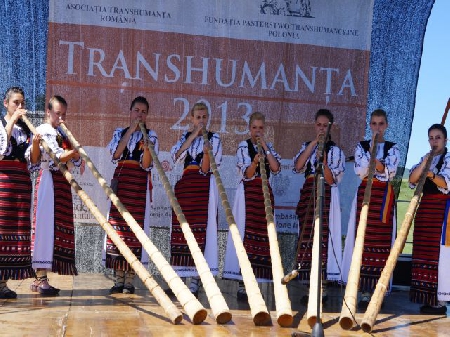Rural tourism in Transylvania
Todays destination is the village of Rotbav, in the central Romanian county of Brasov, a region that preserves a large variety of old traditions.

Daniel Onea, 23.05.2013, 12:42
It is not by coincidence, therefore, that Rotbav was the starting point for this year’s transhumance season, in which 300 sheep were taken 1,400 km north, to their summer pastures in Poland. The start of the seasonal movement of sheep, which this year took place on May 11 in the village of Rotbav, was a special event, and some of the key guests were the alphorn players in the “Doina Motului” ensemble of the Campeni Cultural Centre. We asked the girls how they took up this musical instrument, which, as we know, is large, heavy and rather hard to handle:
“We started playing the alphorn when we were kids, and took part in minor festivals. It was fun, and only later did things become more serious. It’s not as hard as it seems, if you learn the technique and you have someone to explain what to do, anyone can play.”
We asked the girls playing the alphorn in the “Doina Motului” ensemble which of the customs from their native region they believe would be attractive for foreign tourists:
“In the village of Bistra, we have a 250-year old tradition, called ‘Prasor’. This is a celebration held every year, in which groups of more than ten young men from the village go from one house to the other and ask the girls to join the traditional round dance. The so-called Kings and Queens of the dance are chosen, depending on their financial status. The first King is the one who pays the most, and the first Queen is the girl who offers the largest sum of money. People gather to see the first King and Queen opening the dance, and then everybody joins in and they dance and party for three days.”
There are a lot of traditions, and they are all strictly observed in all the villages in the region. Another example is that of lace making, a craft brought over to Transylvania from Flanders by the first Saxon colonists who came here in the Middle Ages, says lacemaker Violeta Carmen Roman. She was born in the Hartbaci Valley area, which has an important Saxon community, and now she lives in the village of Feldioara de Sus, Brasov County:
Violeta Carmen Roman. “In the early 20th Century, this kind of lace making was a widespread craft, and it was common even among the ladies in high society, including Queen Elizabeth and Queen Marie. This is why in Romania this type of lace is also called the ‘queen’s lace.’ I take pride in being the first one to present this kind of lace to the public, and the only one who makes silk lace, using a very special technique.”
Violeta Carmen Roman has worked with the French designer Philippe Guilet for a haute couture collection in which over 50 Romanian craftsmen and artists from Maramures, Bucovina, Brasov, Bistrita and Bucharest were involved:
Violeta Carmen Roman “As part of a project called ‘100% dot Ro’, I worked with French designer Philippe Guilet for a collection called ‘Preconceptions’. This was a haute couture collection comprising 36 items worked exclusively by Romanian craftsmen, coordinated by Philippe Guilet. It was launched on November the 10th at the French Embassy in Bucharest, and it was a remarkable success. Before that, we made two bride dresses, fully accessorised. I took part in international fairs, the most important of which was the Old Lace Festival in Bavaria, where I met the best lace makers in the region. I was awarded a prize for becoming a professional lacemaker on my own, as a self-taught craftswoman.”
Another interesting story is that of the Catean family in Rotbav, Brasov County. The Catean brothers, Silviu, Ionut and George set up a farm and they now breed 100 cows, 1,000 sheep and 11 purebred horses. They sell their meat and dairy products in their own shop in the city of Brasov, they run a traditional boarding house and now they are also involved in a project called Transhumanta 2013. We asked their mother what is there for tourists to do in that region:
“Tourists may visit the sheepfold and see what we do there, or they may see how we make the cheese, down in the village. One of my boys is in charge of the horses, and he’s also a stuntman, so tourists can take horseback riding courses. All around the village there are a lot of fortified churches and medieval citadels. The region is wonderful, and there is plenty to see here.”
In that area, you can always pay a visit to lace maker Violeta Carmen Roman, who told us she has a lot of experience with tourists:
Violeta Carmen Roman: “I can give them lessons in how lace is made. It is an easily-to-learn skill, it takes half an hour or an hour. We can hold a workshop too. We can’t wait to have them over on Pentecost, our village days. For hundreds of years, we’ve had a beautiful custom, in which lads get dressed in traditional outfits and put traditional decorations on horses, they bring birch branches and go around knocking on the doors of lasses, who greet them with food and drinks. I am waiting for everyone to sample my semolina pie, Feldioara style.”
You are invited to enjoy old traditions, the beautiful Saxon churches, nice people, green grass and green forests. Prices are very reasonable, and the food is to die for.






























